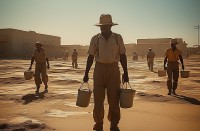
(Reuters) — Before the advent of concrete and steel, arenas and amphitheatres were historically mostly made of wood. This was not without risk, not least from fire – Shakespeare’s Globe Theatre burnt down in 1613 when a prop cannon was fired during a performance of Henry VIII, spitting sparks into the structure’s thatched roof.
But for English soccer club Forest Green Rovers – as their name suggests – wood is the way forward.
They’ve put in planning consent for the world’s first modern-age wooden stadium with an initial capacity for 5,000 spectators and incorporating a host of sustainable, eco-positive features.
“The really big deal is the fact that it’s all made out of wood; minimum use of concrete,” Dale Vince, Forest Green Rovers’ chairman, told Reuters.
“If you look at the carbon impact of sports stadia through their working life, 75 percent of that impact comes from the materials that they’re made with, so it’s not the running cost. Wood is of course a very sustainable material, low in carbon. So that’s our starting point really — we’ll make it from the least impactful material that we can.”
More than 50 proposed designs were submitted from international architects during a seven month competition. The final design was chosen from the award-winning practice of Dame Zaha Hadid. Hadid’s projects include the MAXXI museum in Rome, the London Aquatics Centre used in the 2012 summer Olympics and the Heydar Aliyev Centre in Baku, Azerbaijan.
While Hadid herself died suddenly in March 2016, so was not personally involved in the project, her “architectural philosophy and design language” is present in the final design, according to her firm Zaha Hadid Architects.
“We are thrilled to have been selected to design one of the greenest stadiums in the world. We have always believed that sustainable architecture can and should be beautiful. The new all timber stadium for Forest Green Rovers will be a truly outstanding project,” Sara Klomps, project director for the stadium from Zaha Hadid Architects told Reuters.
Forest Green Rovers, founded in 1889, are currently based at The New Lawn in Nailsworth, Gloucestershire, south-west England. The proposed new site is just over 5 miles (8 km) away.
Vince, founder of British green energy suppliers Ecotricity, got involved with the club in 2010 when it was facing a less-than-rosy future, with financial problems and an outdated ground. In the last few years, Vince has instigated what they call the ‘Green Revolution’ at the club with an organic pitch, solar power, robotic lawnmower, and an all-vegan menu among their green initiatives.
It soon became clear, however, the club would have to re-locate if it were to fulfil its potential, said Vince.
“From the football club’s perspective we’re stuck in a place that’s difficult to get to, we’ve doubled the crowd in the last few years since we’ve been involved. We’ve got ambitions to get from where we are which is tier five of English football to tier two – the Championship,” he said.
Among the planned innovations, Forest Green Rovers’ new stadium will feature a translucent roof to reduce shadows on the pitch; improving the game itself but also aiding the grass growth. The shape and position of the tunnels around pitch are designed to allow the wind to pass through, which again aids the grass growth and cools the pitch during summer without the need for the big fans which you might find at Premiership clubs.
Any risk of the stadium becoming a multi-million pound bonfire are unfounded, said Vince. With modern fire-retardant treatments on timber it should actually be safer than steel-constructed stadium which are at greater risk of collapse, whereas timber using modern methods simply chars.
The stadium with be the centre-piece for Eco Park, a £100 million sports and green technology business park in Gloucestershire. It will also be Ecotricity’s new headquarters.
“We’re looking to the future for Ecotricity as well as for Forest Green, and we’ve found the perfect location we think to build something that’s going to be really ‘out there’ in terms of its environment design and infrastructure,” he said. “It’ll be eco by name and by nature as you might imagine.”
A planning decision is expected in the first half of 2017, with Vince hopeful they will break ground sometime at the start of 2018. The soccer club’s current ground, The New Lawn, will be redeveloped into a number of sustainable, eco-homes.
On Forest Green Rover’s official website the mood is mostly positive for what the new stadium will mean for the club. One forum contributor wrote: “No doubt it will all take time to come to fruition but another big step forward for FGR on the horizon – off and on the pitch.”







